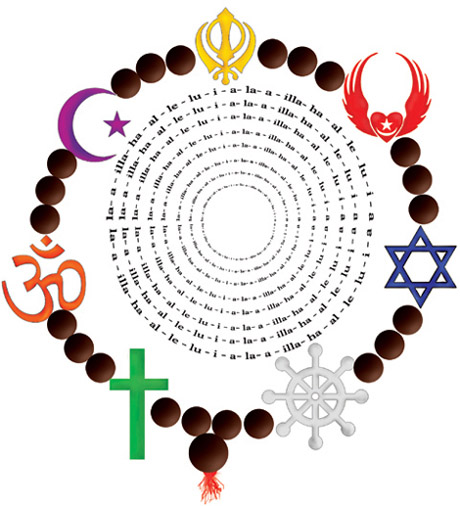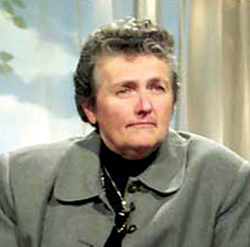- Home
- Archive -May 2009
- The gift of the. . .

The gift of the contemplatives
- In :
- Personal Growth
May 2009
By Joan Chittister
The looks on their faces as they went round and round me was something I had never seen before in my religious life. I realised as they all went by that something very different had just happened in this assembly. The Sufi drum beat an even pace while the group sang “La-a-illa-ha” over and over again, then, alternatively, “al-le-lu-i-a,” and then Amazing Grace. All of them sung rhythmically, softly, persistently – full heartedly, which a person could surely expect of Sufis.
 Contemplatives from all the traditions of the world came together in a powerful expression of oneness at a conference sponsored by the Global Peace Initiative of Women, recently Contemplatives from all the traditions of the world came together in a powerful expression of oneness at a conference sponsored by the Global Peace Initiative of Women, recently |
The people at this zikr, dancing and chanting around the Sufis who were leading it, were not members of one of Islam’s Sufi orders – religious groups much like Christian religious orders around the world. They were Buddhist monks, Jewish rabbis, Hindu swamis, Christian monks, Muslim imams, Indian Sun Dancers, and lay practitioners of all the world’s great contemplative traditions. This zikr, this particular Sufi devotion of praise, was suddenly a universal one, truly a prayer of all these people from all these separate traditions praying the same prayer, but differently.
It was a moment not to be forgotten too quickly in spiritual life. It was, a Christian mystic might have said in earlier centuries, “a foretaste of heaven”. It was, at the very least, a glimpse into what real religion could be – should be. It was a moment of real contemplative oneness.
 Sr Joan Chittister |
Contemplative oneness
While the world around us is turning upside down politically, economically, and socially these days – trying to figure out what “change” really is, what it means to be “pragmatic”, how to get out of the economic dry well into which we have fallen – there were clearly other changes going on at the same time.
These religious changes are not charged with the same kind of urgency, of course, as the political or economic ones. They are neither as obvious nor as defined as bail-outs and stimulus packages. These changes are even under the radar in most instances, and it is not the idea of religion that most people grew up with in the 20th century.
This new world of religion showed itself in Aspen last month at a conference sponsored by the Global Peace Initiative of Women titled “Gathering the Spiritual Voices of Americans: To Deepen Our Knowing of Oneness and Our Compassion as a Nation.” (GPIW.org) The purpose of the conference was, the programme said clearly, to be “A National Reflection with America’s Religious and Spiritual Leaders.” The group had been called together the day after the national election to consider what it means to move from “Contemplative Wisdom to Compassionate Action”.
Over 100 recognised voices of religion’s great contemplative traditions came together at a time of great change to ask themselves what change would be demanded of them, as a result of the social changes going on around them. As one of the questions to the group put it, “What is the call of our time and how must we (as contemplatives) respond?”
Addressing such a question to professed contemplatives of any particular spiritual path might seem a strange one to those who think that the “contemplative” is one who seeks to escape the world. Nevertheless, to those who understand contemplation to be the spiritual commitment to see the world as God sees the world, the conference and its question make serious sense. Some of Catholicism’s greatest contemplatives, for instance, Catherine of Siena, Therese of Avila, Francis of Assisi, Thomas Merton, and Dorothy Day, were also its greatest activists.
A call to action
What does God want at times such as this from those who spend their lives transcending ideologies, immersed in the mystic traditions of the various faiths, more given to the spiritual dimensions of life than to the maintaining of religious institutions themselves?
From one point of view, the questions were actually pretty standard for religious types. However, this time the difference was not so much the answers they came up with – as impacting as these could be – as it was the fact that they came to the conference at all; came together at all. They came to talk about the healing function of contemplation and compassion in the world rather than about church documents, canons, scriptures, or customs that are the hallmark of each.
So surprising was the gathering and its focus, in fact, that a public seminar had to be added to the private consultation just to accommodate some of the people who had heard about the conference and wanted to attend it themselves.
The struggle between “red states” and “blue states” in the United States may be a political problem, but, if truth were told, “oneness” is not something religion has been particularly good at over time either. Religions and religious professionals have been far more devoted over the years to creating absolutes of themselves. They routinely cast other religious and their scriptures and prayers and beliefs into hellfire. They persecuted and oppressed and either forced people into their own religious tribe or hounded them out of it. They made converts at the end of a sword, divided families, and called one another pagans and infidels. Many still do.
Oneness incarnate
However, those attitudes were not here in these people at this conference. Young women rabbis with orthodox rabbis beside them led the Shabbat prayers. Native Americans did the sun-up ceremony. Buddhists chanted. Christians said traditional prayer forms and imams led Friday prayer. In addition, together they all did the zikr. It was the look of common spiritual transcendence and contemplative oneness that I saw on the faces that circled around me.
The Global Peace Initiative of Women works to reduce conflict around the world by calling religious leaders to work to mitigate its local dangers. Where better a place to start than in the contemplative centre of religion itself? If churches, mosques, and temples will not do it – if there is anything to religion at all – someone must.
Oh, before they left, they had made some resolutions, of course. Conferences always do. (You can read the press release on the Global Peace Initiative website.) However, in a sense, these monastics, rabbis, swamis, sufis, and native Americans had already accomplished the greatest thing of all. They had come together – and promised to do it again.
Eliminating barriers between the traditions, modelling the “oneness” religion talks about, what they decided is demanded of the religious at this moment in history. From where I stand, that would be a real revolution. That might do in the end as much or more to change the world than economic structures ever will.
From Where I Stand by Joan Chittister, OSB November 26, 2008, Vol. 6, No. 12 Reprinted with permission from The Catholic Examiner
www.ncronline.org, www.ncronline.org
www.benetvision.org
We welcome your comments and suggestions on this article. Mail us at editor@lifepositive.net
To read more such articles on personal growth, inspirations and positivity, subscribe to our digital magazine at subscribe here
Life Positive follows a stringent review publishing mechanism. Every review received undergoes -
- 1. A mobile number and email ID verification check
- 2. Analysis by our seeker happiness team to double check for authenticity
- 3. Cross-checking, if required, by speaking to the seeker posting the review
Only after we're satisfied about the authenticity of a review is it allowed to go live on our website
Our award winning customer care team is available from 9 a.m to 9 p.m everyday
The Life Positive seal of trust implies:-
-
Standards guarantee:
All our healers and therapists undergo training and/or certification from authorized bodies before becoming professionals. They have a minimum professional experience of one year
-
Genuineness guarantee:
All our healers and therapists are genuinely passionate about doing service. They do their very best to help seekers (patients) live better lives.
-
Payment security:
All payments made to our healers are secure up to the point wherein if any session is paid for, it will be honoured dutifully and delivered promptly
-
Anonymity guarantee:
Every seekers (patients) details will always remain 100% confidential and will never be disclosed
